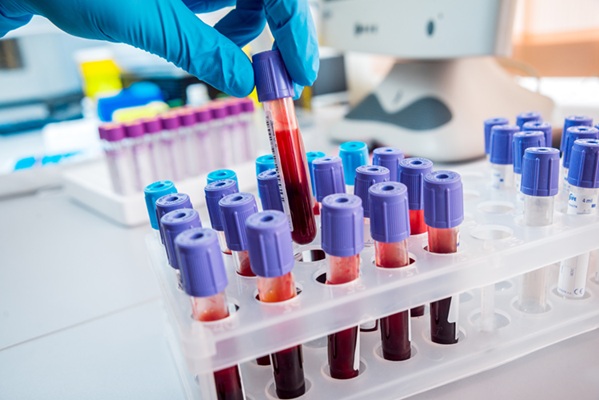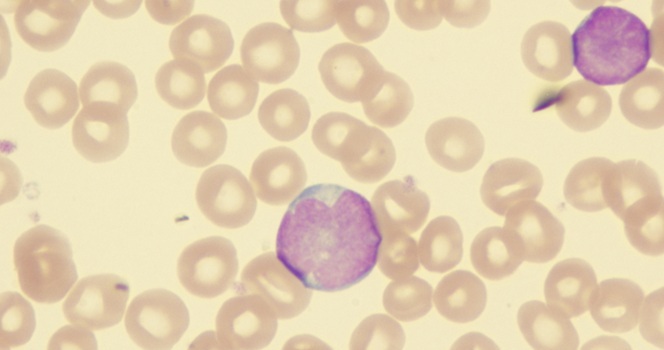Blood Test for Fungal Infections Could End Invasive Tissue Biopsies
|
By LabMedica International staff writers Posted on 06 Feb 2025 |

For individuals with weakened immune systems, common molds found in the environment—such as in the soil, on damp walls, or on forgotten fruits—can lead to severe infections deep within the body. In patients undergoing chemotherapy or organ transplant recipients on immunosuppressive drugs, these molds are most likely to infect the lungs. It is estimated that between 5% and 10% of these patients will develop invasive mold disease. These infections can become life-threatening if not treated promptly, yet they are challenging to diagnose, often presenting as lesions on CT scans. Traditionally, diagnosing invasive mold infections involves obtaining a sample of the mold, either through tissue biopsy or bronchoalveolar lavage, where a scope is used to wash out the lungs with saline solution. The mold sample is then cultured and analyzed in a laboratory to determine the appropriate antifungal treatment. However, many immunocompromised patients are too unstable to undergo such invasive procedures, resulting in delayed diagnosis and treatment. Now, a new blood test has been developed that offers a safer and faster alternative to diagnose invasive mold disease, by detecting mold's genetic material, which could replace invasive tests in most cases.
Researchers at Stanford Medicine (Stanford, CA, USA) have been working on this non-invasive alternative for several years—a blood test that can detect small fragments of mold DNA that have entered the bloodstream. The underlying method, known as cell-free DNA polymerase chain reaction (PCR), often referred to as liquid biopsy, has already shown promise in identifying various infections and even cancer. This new mold test was introduced at Stanford Health Care in late 2020. To make it viable, the researchers refined protocols for collecting blood, extracting DNA, and accurately identifying a range of common mold species. With these optimizations in place, the test was ready for comparison with traditional diagnostic methods.
In the new study published in Clinical Infectious Diseases, the research team reviewed 506 cases in which patients suspected of having mold infections underwent both the blood test and a more invasive test within a one-week period. The majority of these patients were immunocompromised. The study found that when both tests were evaluated according to the standard diagnostic criteria for invasive mold disease, the results matched 88.5% of the time. This means that most patients could avoid the risk of invasive procedures. However, the blood test was less likely to detect infections in the sinuses or limbs, and for these areas, tissue biopsy should still be considered. The key advantage of the blood test lies in its faster turnaround time, which takes just one day, whereas invasive procedures can take several days or even weeks to schedule and provide results.
Currently, Stanford Health Care is the only institution offering this new mold test. Since its introduction, demand has been steadily increasing, with around 3,000 tests ordered each month. While the current version of the test requires significant laboratory resources, automation, and trained personnel, the research team is collaborating with companies to commercialize the test. Their goal is to develop a standalone device that can automate the process. Additionally, the team is working on expanding the use of cell-free DNA PCR tests to diagnose other difficult-to-detect infections. One of their initial targets was tuberculosis, the world’s leading infectious cause of death, with a significant portion of cases remaining undiagnosed. However, developing a highly accurate blood test for tuberculosis has proven to be more challenging.
Related Links:
Stanford Medicine
Latest Molecular Diagnostics News
- New Blood Biomarkers Help Diagnose Pregnancy-Linked Liver Complication
- Simple Urine Test to Revolutionize Bladder Cancer Diagnosis and Treatment
- Blood Test to Enable Earlier and Simpler Detection of Liver Fibrosis
- Genetic Marker to Help Children with T-Cell Leukemia Avoid Unnecessary Chemotherapy
- Four-Gene Blood Test Rules Out Bacterial Lung Infection
- New PCR Test Improves Diagnostic Accuracy of Bacterial Vaginosis and Candida Vaginitis
- New Serum Marker-Editing Strategy to Improve Diagnosis of Neurological Diseases
- World’s First Genetic Type 1 Diabetes Risk Test Enables Early Detection
- Blood Test to Help Low-Risk Gastric Cancer Patients Avoid Unnecessary Surgery
- First-Of-Its-Kind Automated System Speeds Myeloma Diagnosis
- Blood Protein Profiles Predict Mortality Risk for Earlier Medical Intervention
- First Of Its Kind Blood Test Detects Gastric Cancer in Asymptomatic Patients
- Portable Molecular Test Detects STIs at POC in 15 Minutes
- Benchtop Analyzer Runs Chemistries, Immunoassays and Hematology in Single Device
- POC Bordetella Test Delivers PCR-Accurate Results in 15 Minutes
- Pinprick Blood Test Could Detect Disease 10 Years Before Symptoms Appear
Channels
Clinical Chemistry
view channel
Chemical Imaging Probe Could Track and Treat Prostate Cancer
Prostate cancer remains a leading cause of illness and death among men, with many patients eventually developing resistance to standard hormone-blocking therapies. These drugs often lose effectiveness... Read more
Mismatch Between Two Common Kidney Function Tests Indicates Serious Health Problems
Creatinine has long been the standard for measuring kidney filtration, while cystatin C — a protein produced by all human cells — has been recommended as a complementary marker because it is influenced... Read moreMolecular Diagnostics
view channel
New Blood Biomarkers Help Diagnose Pregnancy-Linked Liver Complication
Intrahepatic cholestasis of pregnancy (ICP) is the most common liver disorder linked to pregnancy and can pose serious risks for both mother and baby, including premature delivery and stillbirth.... Read more
Simple Urine Test to Revolutionize Bladder Cancer Diagnosis and Treatment
Bladder cancer is one of the most common and deadly urological cancers and is marked by a high rate of recurrence. Diagnosis and follow-up still rely heavily on invasive cystoscopy or urine cytology, which... Read moreHematology
view channel
MRD Tests Could Predict Survival in Leukemia Patients
Acute myeloid leukemia is an aggressive blood cancer that disrupts normal blood cell production and often relapses even after intensive treatment. Clinicians currently lack early, reliable markers to predict... Read more
Platelet Activity Blood Test in Middle Age Could Identify Early Alzheimer’s Risk
Early detection of Alzheimer’s disease remains one of the biggest unmet needs in neurology, particularly because the biological changes underlying the disorder begin decades before memory symptoms appear.... Read more
Microvesicles Measurement Could Detect Vascular Injury in Sickle Cell Disease Patients
Assessing disease severity in sickle cell disease (SCD) remains challenging, especially when trying to predict hemolysis, vascular injury, and risk of complications such as vaso-occlusive crises.... Read more
ADLM’s New Coagulation Testing Guidance to Improve Care for Patients on Blood Thinners
Direct oral anticoagulants (DOACs) are one of the most common types of blood thinners. Patients take them to prevent a host of complications that could arise from blood clotting, including stroke, deep... Read moreMicrobiology
view channel
Rapid Diagnostic Test Matches Gold Standard for Sepsis Detection
Sepsis kills 11 million people worldwide every year and generates massive healthcare costs. In the USA and Europe alone, sepsis accounts for USD 100 billion in annual hospitalization expenses.... Read moreRapid POC Tuberculosis Test Provides Results Within 15 Minutes
Tuberculosis remains one of the world’s deadliest infectious diseases, and reducing new cases depends on identifying individuals with latent infection before it progresses. Current diagnostic tools often... Read more
Rapid Assay Identifies Bloodstream Infection Pathogens Directly from Patient Samples
Bloodstream infections in sepsis progress quickly and demand rapid, precise diagnosis. Current blood-culture methods often take one to five days to identify the pathogen, leaving clinicians to treat blindly... Read morePathology
view channel
Rapid Low-Cost Tests Can Prevent Child Deaths from Contaminated Medicinal Syrups
Medicinal syrups contaminated with toxic chemicals have caused the deaths of hundreds of children worldwide, exposing a critical gap in how these products are tested before reaching patients.... Read more
Tumor Signals in Saliva and Blood Enable Non-Invasive Monitoring of Head and Neck Cancer
Head and neck cancers are among the most aggressive malignancies worldwide, with nearly 900,000 new cases diagnosed each year. Monitoring these cancers for recurrence or relapse typically relies on tissue... Read more
Common Health Issues Can Influence New Blood Tests for Alzheimer’s Disease
Blood-based tests for Alzheimer’s disease are transforming diagnosis by offering a simpler alternative to spinal taps and brain imaging. However, many people evaluated at memory clinics also live with... Read more
Blood Test Formula Identifies Chronic Liver Disease Patients with Higher Cancer Risk
Chronic liver disease affects millions worldwide and can progress silently to hepatocellular carcinoma (HCC), one of the deadliest cancers globally. While surveillance guidelines exist for patients with... Read moreTechnology
view channel
Artificial Intelligence Model Could Accelerate Rare Disease Diagnosis
Identifying which genetic variants actually cause disease remains one of the biggest challenges in genomic medicine. Each person carries tens of thousands of DNA changes, yet only a few meaningfully alter... Read more
AI Saliva Sensor Enables Early Detection of Head and Neck Cancer
Early detection of head and neck cancer remains difficult because the disease produces few or no symptoms in its earliest stages, and lesions often lie deep within the head or neck, where biopsy or endoscopy... Read moreIndustry
view channel
Abbott Acquires Cancer-Screening Company Exact Sciences
Abbott (Abbott Park, IL, USA) has entered into a definitive agreement to acquire Exact Sciences (Madison, WI, USA), enabling it to enter and lead in fast-growing cancer diagnostics segments.... Read more







 Analyzer.jpg)












